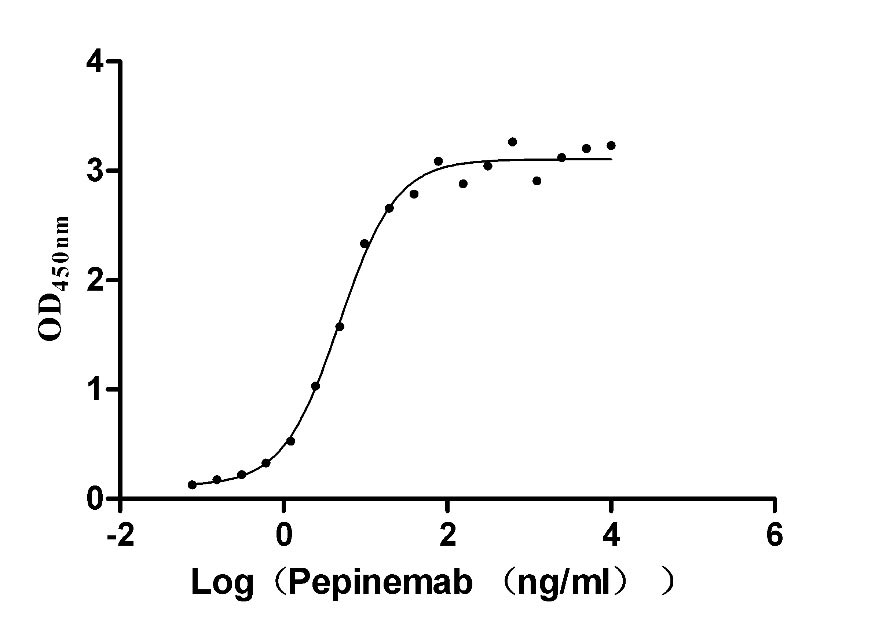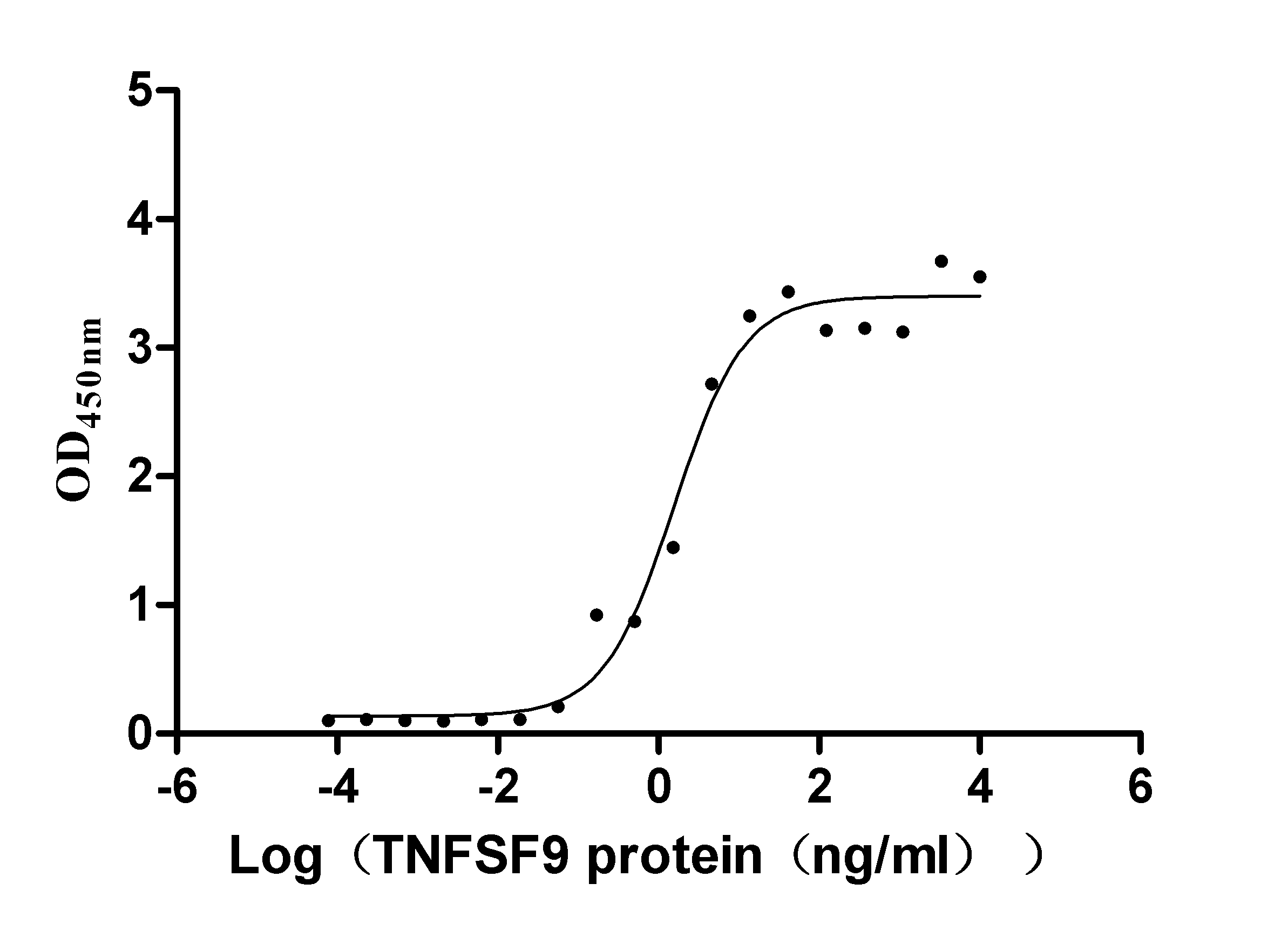Recombinant Mouse Tumor necrosis factor receptor superfamily member 13B (Tnfrsf13b), partial
-
中文名称:小鼠Tnfrsf13b重组蛋白
-
货号:CSB-YP863678MO
-
规格:
-
来源:Yeast
-
其他:
-
中文名称:小鼠Tnfrsf13b重组蛋白
-
货号:CSB-EP863678MO
-
规格:
-
来源:E.coli
-
其他:
-
中文名称:小鼠Tnfrsf13b重组蛋白
-
货号:CSB-EP863678MO-B
-
规格:
-
来源:E.coli
-
共轭:Avi-tag Biotinylated
E. coli biotin ligase (BirA) is highly specific in covalently attaching biotin to the 15 amino acid AviTag peptide. This recombinant protein was biotinylated in vivo by AviTag-BirA technology, which method is BriA catalyzes amide linkage between the biotin and the specific lysine of the AviTag.
-
其他:
-
中文名称:小鼠Tnfrsf13b重组蛋白
-
货号:CSB-BP863678MO
-
规格:
-
来源:Baculovirus
-
其他:
-
中文名称:小鼠Tnfrsf13b重组蛋白
-
货号:CSB-MP863678MO
-
规格:
-
来源:Mammalian cell
-
其他:
产品详情
-
纯度:>85% (SDS-PAGE)
-
基因名:
-
Uniprot No.:
-
别名:Tnfrsf13b; Taci; Tumor necrosis factor receptor superfamily member 13B; Transmembrane activator and CAML interactor; CD antigen CD267
-
种属:Mus musculus (Mouse)
-
蛋白长度:Partial
-
蛋白标签:Tag type will be determined during the manufacturing process.
The tag type will be determined during production process. If you have specified tag type, please tell us and we will develop the specified tag preferentially. -
产品提供形式:Lyophilized powder
Note: We will preferentially ship the format that we have in stock, however, if you have any special requirement for the format, please remark your requirement when placing the order, we will prepare according to your demand. -
复溶:We recommend that this vial be briefly centrifuged prior to opening to bring the contents to the bottom. Please reconstitute protein in deionized sterile water to a concentration of 0.1-1.0 mg/mL.We recommend to add 5-50% of glycerol (final concentration) and aliquot for long-term storage at -20℃/-80℃. Our default final concentration of glycerol is 50%. Customers could use it as reference.
-
储存条件:Store at -20°C/-80°C upon receipt, aliquoting is necessary for mutiple use. Avoid repeated freeze-thaw cycles.
-
保质期:The shelf life is related to many factors, storage state, buffer ingredients, storage temperature and the stability of the protein itself.
Generally, the shelf life of liquid form is 6 months at -20°C/-80°C. The shelf life of lyophilized form is 12 months at -20°C/-80°C. -
货期:Delivery time may differ from different purchasing way or location, please kindly consult your local distributors for specific delivery time.Note: All of our proteins are default shipped with normal blue ice packs, if you request to ship with dry ice, please communicate with us in advance and extra fees will be charged.
-
注意事项:Repeated freezing and thawing is not recommended. Store working aliquots at 4°C for up to one week.
-
Datasheet :Please contact us to get it.
相关产品
靶点详情
-
功能:Receptor for TNFSF13/APRIL and TNFSF13B/TALL1/BAFF/BLYS that binds both ligands with similar high affinity. Mediates calcineurin-dependent activation of NF-AT, as well as activation of NF-kappa-B and AP-1. Involved in the stimulation of B- and T-cell function and the regulation of humoral immunity.
-
基因功能参考文献:
- Data (including data from studies in knockout mice and cells from such mice) suggest that Taci in peritoneal and adipose tissue macrophages is involved in regulation of adipogenesis leading to obesity. PMID: 29871859
- results suggest that TACI A181E heterozygosity results in TACI haploinsufficiency with increased susceptibility to pneumococcal infection PMID: 27609654
- this study shows that increased TACI expression in B cells derived from non-obese diabetic mice contributes to the pathogenesis of type 1 diabetes NOD mice PMID: 27444337
- splenic B cells from TACI-deficient (TACI- / -) mice were unable to secrete IL-10 following TLR stimulation, and TACI- / - mice had undetectable basal serum concentrations of IL-10. PMID: 26139429
- Taci (-/-) mice and BAFF transgenic mice both develop signs of human Systemic Lupus Erythematosus. PMID: 25866827
- Elimination of B lymphocyte stimulator receptor 3 (BR-3) and TACI inhibits the development of SLE in NZM mice. PMID: 25989238
- TACI deficiency has a role in alternatively activated macrophage phenotype and susceptibility to Leishmania infection PMID: 26170307
- The released sTACI is an immunoregulator that shares decoy functions with atacicept. It reflects systemic and compartmentalized B cell accumulation and activation. PMID: 25505277
- Mice lacking TACI are able to clear Citrobacter rodentium, a model pathogen for severe human enteritis, more rapidly than did wild type mice. PMID: 25271628
- reduced TACI expression is responsible for the unresponsiveness of XID mouse to TI-2 Ags and BCR activation controls TACI expression. PMID: 24646744
- TACI is dispensable for the development of SLE in NZM mice. BAFF-TACI interactions contribute to SLE. PMID: 23334904
- TACI promotes sustained Blimp-1 expression by B cells responding to antigen, which in turn limits B-cell clonal expansion and facilitates differentiation of long-lived antibody-secreting cells. PMID: 21984806
- Mice deficient in TACI, a receptor for BLyS and APRIL, mounted an initial antiviral B cell response similar to that generated in WT mice but failed to sustain protective Ab titers. PMID: 21881204
- The C76R TACI mutation disrupts B cell function with lymphoproliferation and immunoglobulin production defects. PMID: 21458042
- MyD88 controls a B cell-intrinsic, TIR-independent, TACI-dependent pathway for immunoglobulin diversification PMID: 20676093
- Loss of TACI causes fatal lymphoproliferation and autoimmunity, establishing TACI as an inhibitory BLyS receptor. PMID: 12594954
- TACI and BAFF-R are able to transduce signals that result in isotype switching in B cells. PMID: 15630136
- Review. Short-lived antibody forming cell populations and their proliferating progenitors express a TACI-predominant signature. PMID: 16919470
- This review defines the exact contribution of TACI receptor stimulation by specific triggers in vitro, enabling us to better understand the complex, context-dependent responses initiated by TACI in vivo. PMID: 17171762
- Data suggest a novel role for TACI in anti-chromatin B cell homeostasis and differentiation. PMID: 17369193
- Our findings corroborate the notion that B cell deviations contribute to type 1 diabetes development, and suggest a temporal regulation of TACI(high) expression, possibly influenced by the ongoing autoimmune process. PMID: 17656068
- TACI has dual B cell-autonomous functions, inhibiting prolonged B cell proliferation and stimulating plasma cell differentiation PMID: 17675489
- A review of TACI function including regulation of B cell function. PMID: 18514565
- findings demonstrate that low TACI expression may be a critical factor that determines the susceptibility of newborns to infections with encapsulated bacteria and the impaired immunogenicity of polysaccharide vaccines PMID: 18606649
- mTACI A144E mutation and its human counterpart, A181E, disrupt TACI signaling and impair TACI-dependent B-cell functions. PMID: 19605846
显示更多
收起更多
-
亚细胞定位:Membrane; Single-pass type III membrane protein.
-
数据库链接:
KEGG: mmu:57916
STRING: 10090.ENSMUSP00000010286
UniGene: Mm.265915
Most popular with customers
-
Recombinant Human Semaphorin-4D (SEMA4D), partial (Active)
Express system: Mammalian cell
Species: Homo sapiens (Human)
-
Recombinant Human Tumor necrosis factor receptor superfamily member 9 (TNFRSF9), partial (Active)
Express system: Mammalian cell
Species: Homo sapiens (Human)
-
Recombinant Human IGF-like family receptor 1 (IGFLR1), partial (Active)
Express system: Mammalian cell
Species: Homo sapiens (Human)
-
Recombinant Human Intestinal-type alkaline phosphatase (ALPI) (Active)
Express system: Mammalian cell
Species: Homo sapiens (Human)
-
Recombinant Human Cadherin-17 (CDH17), partial (Active)
Express system: Mammalian cell
Species: Homo sapiens (Human)
-
Recombinant Human Cytotoxic and regulatory T-cell molecule (CRTAM), partial (Active)
Express system: Mammalian cell
Species: Homo sapiens (Human)
-
Recombinant Macaca fascicularis Transmembrane 4 L6 family member 1 (TM4SF1)-VLPs (Active)
Express system: Mammalian cell
Species: Macaca fascicularis (Crab-eating macaque) (Cynomolgus monkey)
-
Recombinant Human Cadherin-6(CDH6),partial (Active)
Express system: Mammalian cell
Species: Homo sapiens (Human)




















